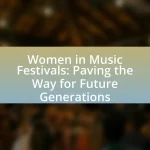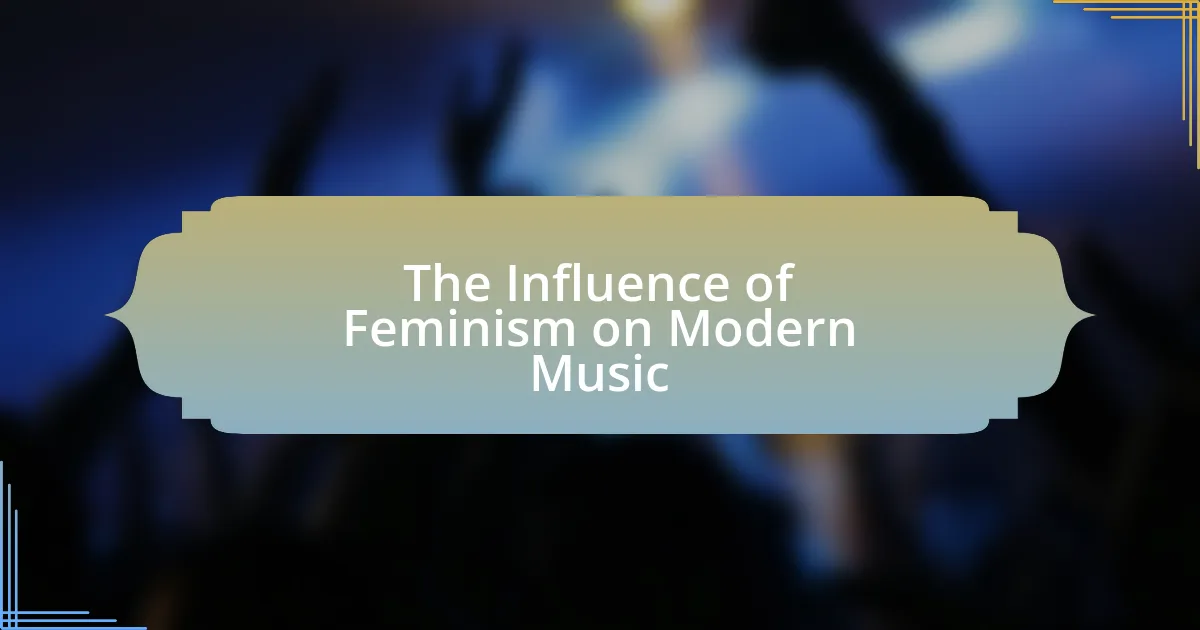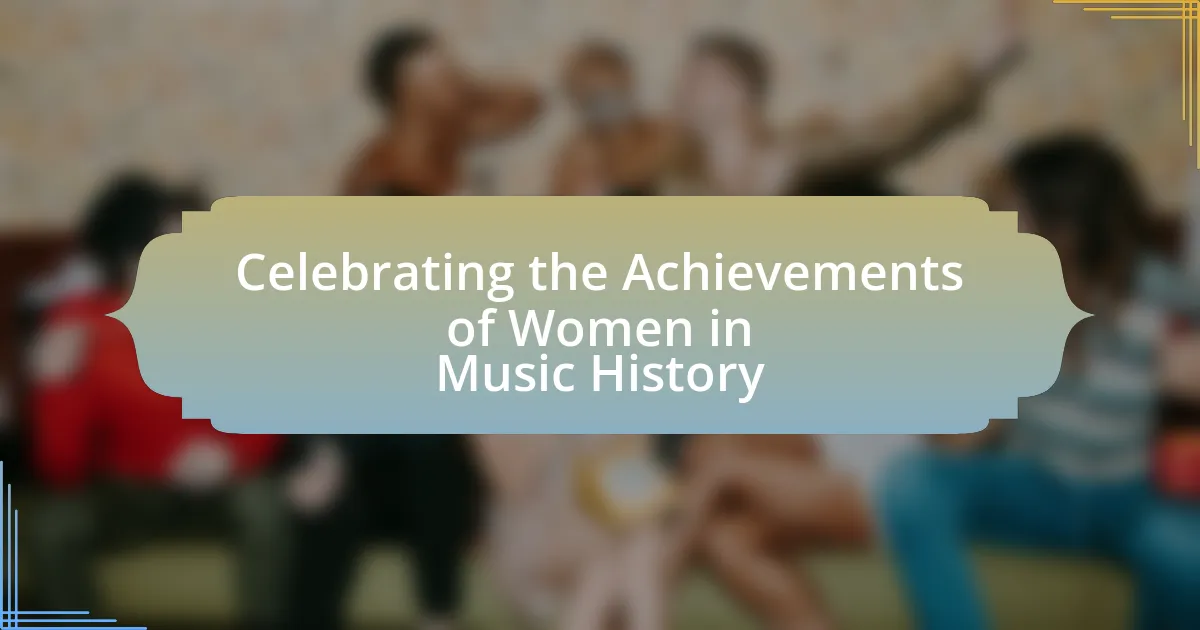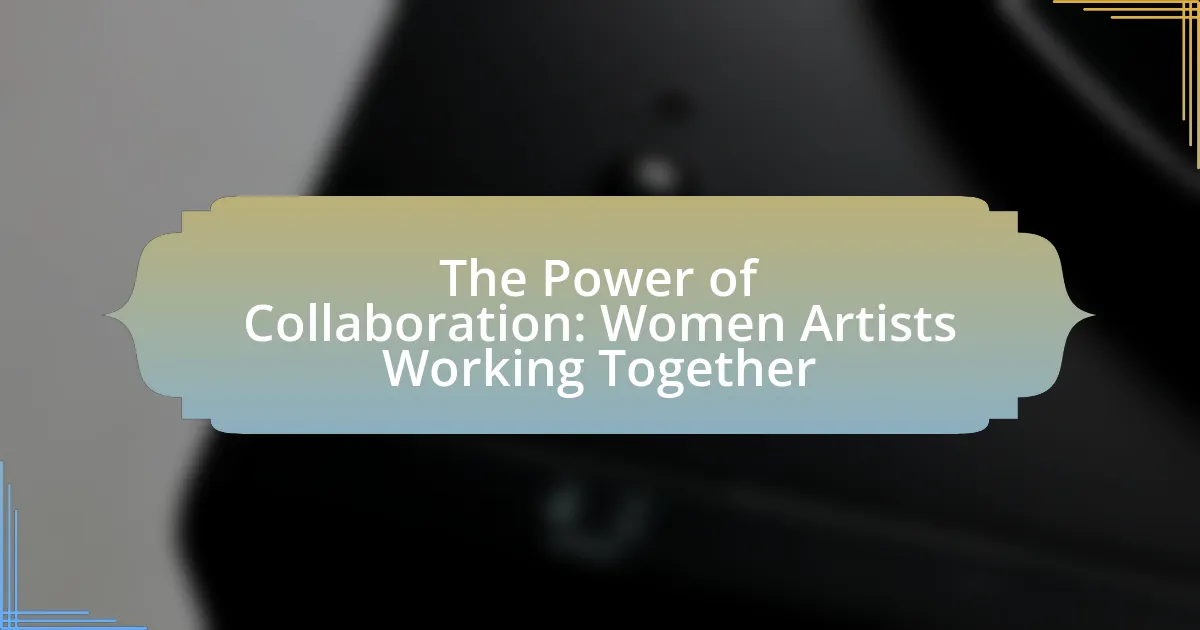The article examines the evolution of women’s voices in indie music from the 1990s to the present, highlighting the significant transformation in representation and diversity. It discusses key historical events, such as feminist movements and the emergence of collectives, that have shaped women’s roles in the genre. The article also analyzes the changing societal attitudes towards female musicians, the defining characteristics of their artistic expressions, and the challenges they face, including gender bias and underrepresentation. Furthermore, it emphasizes the importance of initiatives that support female artists and the impact of notable contemporary musicians on the future of indie music.
What is the Evolution of Women’s Voices in Indie Music?
The evolution of women’s voices in indie music has seen a significant transformation from the 1990s to the present, characterized by increased visibility and diversity. In the 1990s, female artists like Liz Phair and Fiona Apple emerged, challenging traditional gender roles and paving the way for future generations. The 2000s introduced a broader range of styles and influences, with artists such as Feist and Bat for Lashes gaining recognition for their unique sounds and lyrical depth.
By the 2010s, the indie music scene witnessed a surge of female artists, including Mitski and Phoebe Bridgers, who addressed complex themes such as identity, mental health, and societal expectations, resonating with a wider audience. This period also marked the rise of social media, which allowed women in indie music to connect directly with fans and promote their work independently, further amplifying their voices.
Statistical data from the 2020s indicates that women now represent a significant portion of indie music festivals and charts, reflecting a more inclusive industry. The evolution of women’s voices in indie music illustrates a shift towards greater representation and empowerment, highlighting the importance of female perspectives in shaping the genre.
How has the representation of women in indie music changed over the decades?
The representation of women in indie music has significantly evolved from the 1990s to the 2020s, transitioning from marginalization to a more prominent and diverse presence. In the 1990s, female artists were often relegated to supporting roles or stereotypical genres, with few achieving mainstream recognition; for instance, artists like Liz Phair and PJ Harvey began to break through but still faced considerable barriers. By the 2000s, the rise of indie rock and pop saw an increase in female-led bands and solo acts, such as Feist and Bat for Lashes, who gained critical acclaim and commercial success, reflecting a shift towards greater acceptance and visibility.
In the 2010s, the representation of women further expanded, with artists like St. Vincent and Mitski challenging norms and addressing complex themes in their music, showcasing a broader range of experiences and identities. Recent statistics indicate that women now make up approximately 40% of artists in the indie music scene, a significant increase from previous decades, highlighting a growing recognition of female talent and influence. This evolution underscores a cultural shift towards inclusivity and diversity within the indie music genre.
What key historical events influenced women’s roles in indie music?
Key historical events that influenced women’s roles in indie music include the feminist movements of the 1960s and 1970s, which challenged gender norms and encouraged female participation in various artistic fields, including music. The emergence of Riot Grrrl in the early 1990s further propelled women’s voices in indie music by promoting feminist punk rock and addressing issues such as sexism and empowerment. Additionally, the rise of independent record labels in the 1980s and 1990s provided platforms for female artists to create and distribute their music outside of mainstream constraints, allowing for greater creative freedom and visibility. These events collectively shaped the landscape of indie music, enabling women to assert their identities and influence the genre significantly.
How have societal attitudes towards women in music evolved?
Societal attitudes towards women in music have evolved from viewing them primarily as performers or muses to recognizing them as influential creators and leaders in the industry. Historically, women faced significant barriers, often relegated to roles that emphasized their appearance over their musical talent, as seen in the early 20th century when female artists were frequently marketed based on their looks rather than their artistry. In recent decades, the rise of feminist movements and increased visibility of women in various music genres have shifted perceptions, leading to greater acceptance and celebration of female musicians as innovators and key contributors. For instance, the success of artists like Björk and Fiona Apple in the 1990s challenged traditional gender norms, paving the way for contemporary artists such as Billie Eilish and Lizzo, who are now recognized for their artistic integrity and influence. This evolution reflects broader societal changes towards gender equality and the empowerment of women, as evidenced by initiatives like the #MeToo movement, which have further highlighted the importance of women’s voices in all areas, including music.
What are the defining characteristics of women’s voices in indie music?
Women’s voices in indie music are often characterized by emotional authenticity, distinct vocal timbres, and a diverse range of lyrical themes. Emotional authenticity is evident in the way female artists convey personal experiences and vulnerabilities, resonating deeply with listeners. Distinct vocal timbres can vary from ethereal and soft to powerful and gritty, showcasing individuality and artistic expression. Additionally, the lyrical themes often explore topics such as identity, relationships, and social issues, reflecting a broader spectrum of female experiences. This combination of emotional depth, unique vocal qualities, and varied subject matter has contributed to the rich landscape of women’s voices in indie music, making them a vital part of the genre’s evolution.
How do lyrical themes differ in songs by female indie artists?
Lyrical themes in songs by female indie artists often differ from their male counterparts by focusing more on personal experiences, emotional vulnerability, and social issues. Female indie artists frequently explore themes of identity, relationships, and mental health, reflecting a nuanced perspective that emphasizes introspection and authenticity. For instance, studies have shown that women in indie music tend to address topics such as body image and societal expectations more directly than male artists, which can be attributed to their unique experiences in a male-dominated industry. This thematic focus not only highlights the diversity of women’s voices in indie music but also contributes to a broader cultural conversation about gender and representation in the arts.
What musical styles and genres are predominantly explored by women in indie music?
Women in indie music predominantly explore genres such as folk, pop, rock, and electronic. These genres allow female artists to express diverse themes and emotions, often reflecting personal experiences and social issues. For instance, folk music has been a significant platform for storytelling and introspection, with artists like Phoebe Bridgers and Margaret Glaspy gaining recognition for their lyrical depth. In pop, artists like Billie Eilish and Lizzo have redefined mainstream sounds while maintaining indie roots, showcasing individuality and authenticity. Rock has seen influential figures like St. Vincent and Sharon Van Etten, who blend traditional rock elements with innovative sounds. Additionally, electronic music has been shaped by women like Grimes and SOPHIE, who push boundaries and challenge genre conventions. This exploration across various styles highlights the versatility and impact of women in the indie music scene.
Why is the evolution of women’s voices in indie music significant?
The evolution of women’s voices in indie music is significant because it reflects broader societal changes regarding gender representation and empowerment in the music industry. Historically, women in indie music have faced barriers to entry and recognition, but the rise of female artists has led to increased visibility and diversity in the genre. For instance, the success of artists like Fiona Apple and Liz Phair in the 1990s paved the way for contemporary musicians such as Phoebe Bridgers and Mitski, who challenge traditional narratives and explore complex themes of identity and emotion. This shift not only enriches the musical landscape but also inspires future generations of female musicians to express their voices authentically.
What impact has this evolution had on the broader music industry?
The evolution of women’s voices in indie music has significantly diversified the music industry, leading to increased representation and a broader range of musical styles. This shift has resulted in a surge of female artists gaining recognition, with statistics showing that the percentage of women in music festivals has risen from 20% in 2015 to over 40% in 2023. Additionally, the presence of women in songwriting and production roles has expanded, contributing to a richer and more varied soundscape in the indie genre. This evolution has not only challenged traditional gender norms but has also influenced mainstream music trends, as record labels increasingly seek to sign diverse talent to appeal to wider audiences.
How does the evolution of women’s voices reflect cultural shifts?
The evolution of women’s voices in indie music reflects cultural shifts by showcasing changing societal attitudes towards gender roles and empowerment. As women increasingly took on prominent roles in the indie music scene, their lyrics and vocal styles began to express themes of independence, identity, and resistance against traditional norms. For instance, the rise of female artists in the 1990s, such as Liz Phair and Fiona Apple, marked a significant shift towards more candid and assertive expressions of female experiences, challenging the previously male-dominated narratives in music. This trend continued into the 2000s and 2010s with artists like St. Vincent and Mitski, who further pushed boundaries by addressing issues like mental health and sexuality, reflecting broader cultural conversations about feminism and self-acceptance. The increasing visibility and diversity of women’s voices in indie music serve as a barometer for the evolving cultural landscape, indicating a shift towards greater inclusivity and representation in the arts.

What challenges have women faced in the indie music scene?
Women in the indie music scene have faced significant challenges, including gender bias, lack of representation, and limited access to industry resources. Gender bias manifests in the form of stereotypes that question women’s musical abilities and leadership roles, often leading to fewer opportunities for women to perform or be taken seriously as artists. Additionally, women are underrepresented in key industry positions, which affects their visibility and influence within the scene. According to a 2020 report by the Annenberg Inclusion Initiative, women comprised only 22.5% of artists in popular music, highlighting the systemic barriers they encounter. Furthermore, women often face difficulties in securing funding and support for their projects, which can hinder their artistic development and career progression.
How do gender biases manifest in the indie music industry?
Gender biases in the indie music industry manifest through unequal representation, limited access to opportunities, and stereotypical perceptions of female artists. Research indicates that women comprise only about 20% of artists in the indie genre, highlighting significant underrepresentation. Additionally, female musicians often face challenges in securing festival slots, with studies showing that male acts dominate lineups, further marginalizing women’s contributions. Stereotypes also influence how female artists are marketed, often emphasizing appearance over musical talent, which can detract from their artistic credibility. These biases create systemic barriers that hinder the growth and visibility of women’s voices in the indie music scene.
What barriers do female artists encounter in gaining recognition?
Female artists encounter several barriers in gaining recognition, including systemic gender bias, limited access to industry networks, and unequal representation in media coverage. Systemic gender bias manifests in the form of stereotypes that undermine women’s contributions to music, often leading to fewer opportunities for performances and promotions. Limited access to industry networks restricts female artists from connecting with influential figures who can help advance their careers. Additionally, studies show that women are frequently underrepresented in music festivals and award nominations, which further diminishes their visibility and recognition in the industry. For instance, a report by the Annenberg Inclusion Initiative found that only 22.5% of artists on popular music charts were women, highlighting the significant disparity in recognition.
How do these challenges affect the creative expression of women in indie music?
The challenges faced by women in indie music significantly restrict their creative expression. These obstacles include gender bias, lack of representation, and limited access to resources, which can lead to self-censorship and reduced visibility in the industry. For instance, a study by the Annenberg Inclusion Initiative found that only 22.5% of artists in popular music were women, highlighting the systemic barriers that limit opportunities for female musicians. Consequently, these challenges not only hinder women’s ability to share their unique perspectives but also perpetuate a cycle of underrepresentation in the indie music scene.
What role do female-led collectives and networks play in supporting women in indie music?
Female-led collectives and networks play a crucial role in supporting women in indie music by providing platforms for collaboration, mentorship, and visibility. These collectives, such as Girls Rock Camp and She Shreds Magazine, create safe spaces where female musicians can share resources, develop their skills, and connect with industry professionals. Research indicates that women in music face systemic barriers, and these networks help to counteract those challenges by fostering community and empowerment. For instance, a study by the Annenberg Inclusion Initiative found that female-led initiatives significantly increase the representation of women in music festivals and lineups, demonstrating their impact on promoting gender equity in the industry.
How have these collectives contributed to the visibility of women artists?
Collectives have significantly enhanced the visibility of women artists by creating platforms that prioritize their work and foster community support. These groups often organize events, exhibitions, and performances specifically showcasing female talent, which directly counters the historical underrepresentation of women in the music industry. For instance, initiatives like the “Women in Music” organization have been instrumental in promoting female musicians through networking opportunities and mentorship programs, leading to increased recognition and career advancement for women artists. Additionally, research indicates that female-led collectives are more likely to receive media coverage, further amplifying their visibility in a predominantly male-dominated industry.
What resources do they provide to emerging female musicians?
Emerging female musicians are provided with resources such as mentorship programs, funding opportunities, and access to industry networks. Organizations like She Is The Music and Girls Who Code offer mentorship that connects aspiring artists with experienced professionals in the music industry, facilitating skill development and career guidance. Additionally, funding initiatives like the Women’s Audio Mission provide financial support for projects led by women, enabling them to produce and promote their music. Access to industry networks through platforms like SoundGirls allows female musicians to connect with peers and industry leaders, fostering collaboration and visibility. These resources collectively empower emerging female musicians to navigate the challenges of the music industry effectively.
How can we further support the evolution of women’s voices in indie music?
To further support the evolution of women’s voices in indie music, it is essential to increase funding and resources for female artists through grants and sponsorships. Research indicates that women in music receive significantly less funding compared to their male counterparts, with only 12% of music industry funding going to female artists according to a 2021 report by the Annenberg Inclusion Initiative. Additionally, creating more platforms for female-led music festivals and showcases can amplify their visibility and opportunities. By prioritizing mentorship programs that connect established female musicians with emerging talent, the industry can foster a supportive community that encourages growth and collaboration among women in indie music.
What initiatives can promote gender equality in the indie music scene?
Initiatives that can promote gender equality in the indie music scene include mentorship programs, equitable booking practices, and gender-focused music festivals. Mentorship programs connect emerging female artists with established musicians, fostering skill development and industry knowledge. Equitable booking practices ensure that women are represented fairly in lineups, addressing the historical gender imbalance in live performances. Gender-focused music festivals, such as the “Girls Rock!” initiative, provide platforms specifically for female artists, encouraging visibility and networking opportunities. These initiatives are supported by research indicating that increased representation leads to greater opportunities and success for women in the music industry.
How can audiences contribute to the visibility of women in indie music?
Audiences can contribute to the visibility of women in indie music by actively supporting female artists through attendance at their shows, sharing their music on social media, and engaging with their content. When audiences prioritize female-led performances and promote these artists online, they help to amplify their reach and recognition within the industry. For instance, a study by the Annenberg Inclusion Initiative found that women represented only 22.5% of artists in popular music, highlighting the need for increased visibility. By choosing to support women in indie music, audiences can directly influence the industry’s dynamics and encourage more equitable representation.
What best practices can venues and festivals adopt to support female artists?
Venues and festivals can adopt several best practices to support female artists, including implementing equitable booking policies, providing mentorship programs, and ensuring safe performance environments. Equitable booking policies involve actively seeking to balance gender representation in lineups, as studies show that female artists are often underrepresented; for instance, a 2020 report by the Annenberg Inclusion Initiative found that only 22.5% of artists on popular festival lineups were women. Mentorship programs can connect emerging female artists with established professionals, fostering growth and visibility in the industry. Additionally, creating safe performance environments through anti-harassment policies and support systems can encourage more female artists to participate, as safety is a significant concern highlighted in various surveys conducted by organizations like the Music Industry Research Association.
What are some notable female indie artists to watch today?
Notable female indie artists to watch today include Phoebe Bridgers, Mitski, and Julien Baker. Phoebe Bridgers has gained significant acclaim for her introspective songwriting and unique sound, exemplified by her album “Punisher,” which was nominated for multiple Grammy Awards in 2021. Mitski is recognized for her emotionally charged music and powerful performances, with her album “Be the Cowboy” receiving widespread critical praise and featuring the hit single “Nobody.” Julien Baker, known for her raw and honest lyrics, has made a mark with her album “Little Oblivions,” which showcases her growth as an artist and has been well-received by both fans and critics. These artists represent a vibrant and evolving landscape in indie music, highlighting the significant contributions of women in the genre.
How do their contributions shape the future of indie music?
The contributions of women in indie music significantly shape its future by introducing diverse perspectives and innovative sounds. Female artists like Phoebe Bridgers and Mitski have redefined genre boundaries, blending elements of folk, rock, and pop, which encourages experimentation among emerging musicians. Their success has led to increased visibility and opportunities for women in the industry, as evidenced by the rise in female-led festivals and initiatives aimed at promoting gender equality in music. This shift not only inspires new talent but also fosters a more inclusive environment, ensuring that the future of indie music reflects a broader range of experiences and narratives.
What unique perspectives do they bring to the genre?
Women in indie music bring diverse perspectives shaped by their unique experiences, cultural backgrounds, and societal challenges. These artists often address themes such as identity, empowerment, and social justice, which resonate deeply within the genre. For instance, artists like Phoebe Bridgers and Mitski explore mental health and personal struggles, providing authenticity and vulnerability that challenge traditional narratives in music. Additionally, the rise of intersectional feminism in indie music has led to a broader representation of voices, allowing for discussions on race, sexuality, and gender that were previously marginalized. This evolution not only enriches the genre but also fosters a more inclusive environment for listeners and creators alike.
How can aspiring female musicians navigate the indie music landscape?
Aspiring female musicians can navigate the indie music landscape by leveraging social media platforms for promotion, networking with other artists, and participating in local music scenes. Social media allows musicians to reach wider audiences and engage directly with fans, which is crucial in the indie sector where traditional marketing may be limited. Networking with other artists can lead to collaborations and support systems, enhancing visibility and opportunities. Additionally, participating in local music events and festivals can provide exposure and help build a community around their music. According to a 2021 study by the USC Annenberg Inclusion Initiative, female artists are underrepresented in the music industry, making these strategies essential for gaining traction and recognition.




